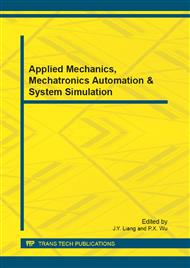p.1006
p.1012
p.1016
p.1021
p.1025
p.1030
p.1036
p.1042
p.1047
An Evolutionary Method of Traditional Artificial Potential Field
Abstract:
The problems of goals non-reachable with obstacles nearby (GNRON) and dead lock caused by local minimum were described when using Artificial Potential Field (APF) methods for mobile robot path planning in complex environment. Considering the geometric relationship of different obstacles, the heuristic factor of virtual attractive forces was introduced to solve the local minimum problem. Simulation results indicate that the evolutionary method of APF can realize optimal path planning in complex environment, which makes up the disadvantages of traditional APF method.
Info:
Periodical:
Pages:
1025-1029
Citation:
Online since:
September 2012
Authors:
Price:
Сopyright:
© 2012 Trans Tech Publications Ltd. All Rights Reserved
Share:
Citation:


